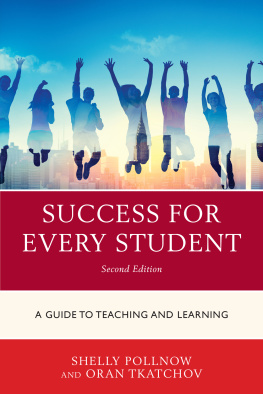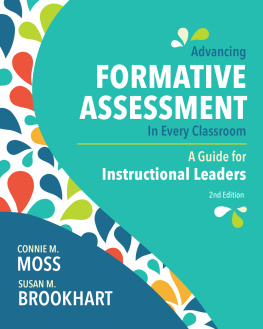
Published by Rowman & Littlefield
A wholly owned subsidiary of The Rowman & Littlefield Publishing Group, Inc.
4501 Forbes Boulevard, Suite 200, Lanham, Maryland 20706
www.rowman.com
Unit A, Whitacre Mews, 26-34 Stannary Street, London SE11 4AB
Copyright 2017 by Shelly Pollnow and Oran Tkatchov
All rights reserved. No part of this book may be reproduced in any form or by any electronic or mechanical means, including information storage and retrieval systems, without written permission from the publisher, except by a reviewer who may quote passages in a review.
British Library Cataloguing in Publication Information Available
Library of Congress Cataloging-in-Publication Data
ISBN: 978-1-4758-3709-4 (electronic)
The paper used in this publication meets the minimum requirements of American National Standard for Information SciencesPermanence of Paper for Printed Library Materials, ANSI/NISO Z39.48-1992.
Printed in the United States of America
Contents
With all the multi tiered interventions, assessment software, aligned textbooks, digital content, and scripted curriculum available to the field, some might question if the role of the teacher is significant in todays schools. Does it really matter who is leading the classroom? The answer to this question is a resounding YES!
Take a minute and think back to your favorite class. Chances are you do not remember the name of the textbook, the name of computer software, or the order in which the curriculum was taught. What you do remember is the person in charge of that class: the teacher.
For one of the authors, it was Mrs. Baron and her creative writing class. He does not remember what period it was or who sat behind him. He doesnt remember what literature was read or even the color of the textbook. He does remember Mrs. Baron making him feel like his work mattered and that he could do better. She showed genuine interest when he did a presentation on the punk-rock poet Henry Rollins and used that moment to convince him to write a paper comparing his anger to the rage in Maya Angelous writing. Because of his teachers encouragement, he had no problem learning about iambic pentameter or actually reading Maya Angelou during free time.
This interest was not instilled by a video collection, a laptop computer, or comfortable classroom furniture; it came from a teacher who possessed the skills necessary to get him excited to learn. The teacher-student bond and meaningful interactions are crucial to student engagement and academic success. Students must feel the support of their teachers while facing the challenges of learning.
Teachers face their own challenges as they grow and learn in the profession; many of them give up quickly because they do not feel supported or have the resources to hone their craft and feel successful. The purpose of this book is to help all teachers become confident in their teaching so that they can be the supportive force that students remember years later when they reflect on their school experience.
Many people have been instrumental in the motivation of this book. The authors would like to thank past and present coworkers, Mary (for all the help making this book worth reading!), Maddie, Alex, Luba, Luda, Tya, Kristen, Tony, Vinnie, and Lucie, and the rest of the Tkatchov/Korostil family, Dave Pollnow, Meagan, Mark, and Parker Pollnow/Murphy, John, and Mary Louise Kraynak and family, Geri and Jim Borgen, Anita Archer, Margaret Heritage, Tom Horne, Cheryl Lebo, Angela Denning, and Phyllis Schwartz.
If I must start somewhere, right here and now is the best place imaginable.
Richelle E. Goodrich
Like a blinking cursor on an empty page, it was just the first thing. The beginning of the beginning. But at least it was done.
Sarah Dessen
Quality teaching is the key to student achievement. Although there are many new resources available to schools, research shows that the individual teachers skills are still essential to student success. John Hattie compiled over 800 meta-analyses in his book, Visible Learning, and found that of all of the variables researchers study that impact the classroom, teachers have the greatest effect on and make the biggest difference in student achievement (Hattie, 2012). Other studies have resulted in the same conclusion: teacher quality appears to be more related to student success than class size and monetary spending (Darling-Hammond, 2000). Students of teachers who can convey higher- and lower-order thinking skills regularly outperform students whose teachers convey only lower-order thinking skills (Langer & Applebee, 1987; Wenglinsky, 2000).
In 2010, the Los Angeles Times published a story, Whos Teaching L.A.s Kids? The Times used value-added analysis to look at the effectiveness of L.A. teachers based on student progress over a seven-year period (Felch, Song, & Smith, 2010). Their data showed the following:
- Effective teachers regularly took students who performed below grade level and boosted them to at or above grade level within one academic year.
- Many students (8,000) in the study had ineffective teachers for two or more years in a row.
- Effective and ineffective teachers were found in all schools, not just rich districts or poor districts. There was a wider gap in teacher effectiveness within a school than between the L.A. schools.
- A parents choice of a teacher could be more influential in the students success than the choice of school. Per the findings, a teacher could have three times as much influence on a students academic progress as the school as a whole.
- A students race, socio-economic background, previous achievement level, or English proficiency did not play a major role in whether or not a teacher was effective.
Prior studies (Sanders & Rivers, 1996) seem to confirm these newer findings that the teacher effect is the most dominant factor affecting students academic gain. How dominant of a factor? The same study showed that students who spend three straight years with the most effective teachers have a 50-percentile point advantage over students who spend three straight years with the least effective teacher.
Another study showed that in one school year, students taught by the top 5 percent of teachers were able to show 1.5 years growth, while students taught by the lowest 5 percent of teachers showed only a years growth (Hanushek, 2009). Remember that it is common for a student to have an ineffective teacher for more than one year in a row. Based on these studies, the influence of a good teacher can alone mean more years of growth for an individual child. On the same note, the influence of a poor teacher can mean years of stagnation or falling behind grade-level peers. The most important resources in schools are teachers, and research shows that effective teachers using sound instructional practices increase student academic achievement.
At this point, one could argue, Well, thats probably true for any profession. Those who get the better employees get better service. This is correct, but in the field of education, all teachers need to be effective because the final product is the future. A poorly made car, sofa, or meal can be easily returned or discarded. A poorly educated child cannot; factory recalls are not an option in education. There will never be a day when the evening newscaster announces, Scottsdale High School issued a product recall on the graduating class of 2012. If you currently employ a member of the class of 12, please return him or her to the district office for a class of 17 upgrade.










